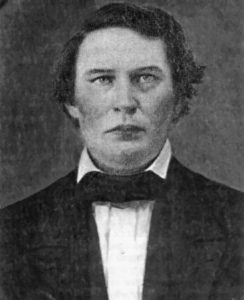Kentucky’s Governor Fought and Fell at Shiloh

On February 8, 1862, Confederate generals Albert Sidney Johnston, P.G.T. Beauregard, and William Hardee conferred on the most recent turn of events in the Western Theater at Beauregard’s Bowling Green, Kentucky, headquarters. Fort Henry fell to Union forces two days earlier. The fall of Fort Donelson seemed inevitable, and Johnston realized he could not hold his line in Kentucky. Three days later, Johnston’s forces withdrew from the state.
Many Confederate leaders and newspaper editors lost faith in Johnston. Kentucky’s Confederate governor George W. Johnson was not one of them.
Johnson planted the roots of a Confederate Kentucky. Opposed to the Unionist Frankfort government, Johnson and former Vice President John C. Breckinridge called a meeting of influential Confederate sympathizers at Russellville, Kentucky, in late October 1861, which led to a larger meeting at the same place the next month. Eventually, these efforts formed the Provisional Government of Kentucky, the state government that the Confederacy recognized (Kentucky was a star on flags of both the United States and Confederate States). As Confederate Kentucky’s governor, Johnson worked diligently to build a government from scratch that represented the entire state, though it had no power outside of Confederate lines. By February 1862, those lines were not even in Kentucky.
Governor Johnson never lost hope of reclaiming Kentucky for the Confederacy. Amid the outcry against Johnston, the governor continued to support him. Though the Confederate “capital of Kentucky was located in a Sibley tent,” Johnson urged the general to retain his command rather than, as rumor said, turn it over to another general. “We are in the right place, at the right time, and the proudest victory of the war awaits you, unless you commit suicide, by yielding up the command of your army when it most needs energy and an active head. You must not do this.”
General Johnston sought that “proudest victory” over Maj. Gen. Ulysses S. Grant’s Army of the Tennessee at Shiloh on April 6, 1862. Governor Johnson, ousted from his own state but still legitimately recognized as the Bluegrass State’s leader by the Confederacy, rode into that battle as an aide to Brig. Gen. John C. Breckinridge. He followed the First Kentucky Brigade throughout the fighting that day and volunteered his services to brigade commander Col. Robert P. Trabue. In the battle, Johnson’s horse was shot from under him. Despite his age–he was 50 years old–and a “withered arm,” Johnson refused another horse and fell into the ranks of Company E, 4th Kentucky Infantry. That night, they officially mustered him in as a private. “They are my friends and relatives,” Johnson said, and he would do battle with them.

On Shiloh’s second day, Johnson was not as lucky as the first day. While a near miss hit his horse then, this time he was struck twice, once in the abdomen and by another ball in the right thigh. In their hasty withdrawal, his newfound Kentucky comrades left Johnson on the battlefield. He did not receive attention until April 8, when a fellow Mason, Union Maj. Gen. Alexander McCook, recognized Johnson from their time together at the Democratic convention in Charleston, South Carolina, in 1860. Federal troops transported the wounded governor to the hospital ship Hannibal.
The work of Federal surgeons could not save Johnson’s life however. He died the next day, April 9. Some of his last words were a justification at his participation in the war: “I wanted personal honor and political liberty and constitutional state government, and for these I drew the sword.”
Though his government was exiled, George W. Johnson is the only Confederate governor to be felled in battle. His dreams of a Confederate Kentucky ultimately never came true.
There is so much forgotten. Great post
Great post! Where did you find his last words and that McCook recognized him?
Solid revelation of the existence of “shadow governments” during the Civil War. In Kentucky, South-leaning Beriah Magoffin (elected Governor in 1859) attempted “armed neutrality” during the early months of the Secession Crisis of 1860/61 but found his hand forced when Southern Rebels invaded Kentucky in September 1861 and took possession of Columbus (which was soon turned into an impregnable fort overlooking the Mississippi River.) The now Union-supporting Magoffin was “replaced” as Governor, as Kevin Pawlak reports in the above article, by George W. Johnson; but only the Confederacy recognized “Governor” Johnson. (Upon his death, George Johnson’s position as Confederate Governor of Kentucky was assumed by Richard Hawes.)
Another Governor who fought at Shiloh: Isham Harris of Tennessee. Elected Governor in 1857, Harris threw his support early behind the budding Confederacy, and helped guide Tennessee out of the Union. Following Grant’s Victory at Fort Donelson, the Confederate Capital of Nashville was abandoned: Governor Harris moved west and re-established the Seat of Government at Memphis. With establishment of Union control in significant portions of North/Central Tennessee, Andrew Johnson was given rank of Brigadier General and set up at Nashville as Military Governor of (Union-controlled) Tennessee.